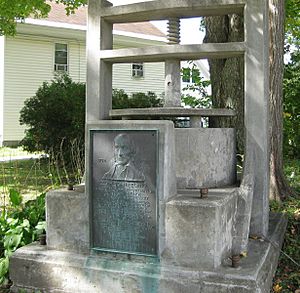Cheshire Mammoth Cheese facts for kids
The Cheshire Mammoth Cheese was an incredible gift given to President Thomas Jefferson in 1802. This giant cheese weighed 1,235-pound (560 kg) (that's more than half a ton!). It was made by combining all the milk from every cow in the town of Cheshire, Massachusetts. The townspeople even built a special, huge cheese press just to make it! The cheese had a special message on it: "Rebellion to tyrants is obedience to God." This showed support for Jefferson and his ideas.
Contents
The Amazing Mammoth Cheese Gift
The town of Cheshire was created in 1793 from parts of other towns. Its first settlers came from Rhode Island. They named their new home New Providence Plantation. Later, it was renamed Stafford Hill to honor Col. Joab Stafford. He had explored the area and led local soldiers against the British during the Battle of Bennington.
At that time, some people worried that President Jefferson, who was a Republican, might not support religious beliefs. They thought he was too much like the people from the French Revolution.
How the Idea Started
However, a pastor in Cheshire named Elder John Leland disagreed. He was a Baptist, and Baptists strongly believed in the separation of church and state. This meant that the government should not control religion, and religion should not control the government. Elder Leland had met Jefferson when he lived in Virginia, and they became friends. Because of this friendship, Leland strongly supported Jefferson for president.
Leland believed his efforts helped Jefferson win the election. So, he encouraged the people of Cheshire to give Jefferson a very special gift. He asked everyone in his church who owned a cow to bring all their milk or cheese curd from one day to a big cider mill. Leland also said that no milk from a "Federal cow" (a cow owned by someone who didn't support Jefferson) should be used. This was to make sure the cheese truly represented the people who supported Jefferson. The cheese was made only by free farmers from Cheshire, Berkshire County, and their families. A letter to President Jefferson said the cheese was made "without the assistance of a single slave."
Making the Giant Cheese
The townspeople brought their milk and curd to the cider mill. They put a huge hoop on the mill to create a giant cheese press. According to one writer, the cheese was made from the milk of 900 cows! The townspeople added their ingredients and even sang a hymn over the press. After some time, the cheese was ready. There was so much milk that they made three smaller cheeses too. But Leland dedicated the biggest one to Jefferson. He called it "the greatest cheese ever put to press in the New World or Old."
The final cheese weighed 1,235 pounds (560 kg). It was 4 feet (1.2 m) wide and 15 inches (380 mm) thick. Because it was so big, it couldn't be moved easily on wheels. So, the town hired a sleigh to take it to a barge on the Hudson River. This was the first part of its long trip to Washington, D.C..
A Journey Across States
The mammoth cheese floated down the Hudson River to New York City. From there, it was loaded onto a boat called the Astrea. It then sailed to Baltimore, Maryland. Finally, it was put on a horse-drawn wagon for the last part of the journey to Washington. The whole trip from Cheshire to Washington took three weeks and covered 500-mile (800 km). As the cheese traveled, word spread, and it became a big event in every town it passed through.
The Cheese Arrives at the White House
The cheese was finally given to President Jefferson on January 1, 1802. Elder Leland saw the cheese as a sign of great respect for Jefferson's election. The town also made a political point in their letter to Jefferson. They wrote that the cheese was made by "freeborn farmers with the voluntary and cheerful aid of their wives and daughters, without the assistance of a single slave."
Even though some people criticized Jefferson and the town for this gift, Jefferson praised it. He called it "extraordinary proof of the skill" of the people of Cheshire. The President then cut a piece of the cheese to give back to the town. Many people thought it was the greatest cheese ever presented at the White House. Jefferson usually didn't like receiving gifts. But he gave a $200 donation to Leland's church as a thank you. This was more than half the actual price of the cheese!
The cheese stayed at the White House for over two years. It was even featured at a public dinner for an Independence Day celebration in 1803. Eventually, it was replaced by something called the "Mammoth Loaf." This was a huge loaf of bread made by the United States Navy from a whole barrel of flour.
The Mammoth Cheese's Legacy
The story of the mammoth cheese has inspired many events since then. In 1837, supporters of President Andrew Jackson ordered a similar giant cheese. They felt that Jackson should receive every honor that Jefferson had. This event later inspired a famous episode on the TV show The West Wing, called "Big Block of Cheese Day."
The cheese also inspired a book for grown-ups called The Mammoth Cheese by Sheri Holman. It tells the story of a cheesemaker who makes a giant cheese for the President. It also inspired a children's picture book called A Big Cheese for the White House by Candace Fleming. The story was also featured on the American history comedy podcast The Dollop.
Today, there is a concrete cheese press monument in Cheshire. It has a plaque dedicated to Elder Leland.


